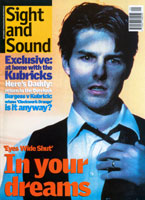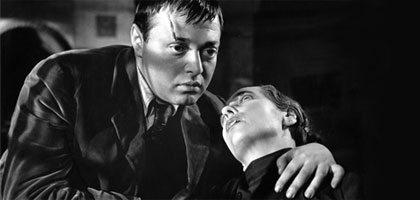Primary navigation

UK 1934

Reviewed by Jonathan Coe
Our synopses give away the plot in full, including surprise twists.
On holiday with their daughter Betty in St Moritz, Bob and Jill Lawrence fall in with three strangers: a French skier called Louis Bernard, a crack marksman called Ramon, and Mr Abbott, who always carries a gently chiming watch. Bernard is assassinated while dancing with Jill, but leaves behind a note referring to 'G Barbor' of Wapping and 'A Hall'. Shortly after reading it, Bob receives a phone call telling him that Betty has been kidnapped and will die if he reveals its contents.
At home in London, the Lawrences learn Bernard was a secret agent who was trying to prevent the assassination of a diplomat in London. Bob goes to Wapping with his friend Clive and they find that 'G Barbor' is a dentist whose surgery is being used as a front by Ramon and Mr Abbott. They follow them to a chapel, where a fight ensues and Bob glimpses a concert ticket in Ramon's pocket. He realises that 'A Hall' must be the Albert Hall, and tells Clive to phone Jill with instructions to go there.
At the Albert Hall concert, Jill screams just before the fatal crash of cymbals which is meant to be Ramon's signal to fire at the diplomat. His shot misses and he escapes, but the police follow him to the spies' hiding place. There is a shoot-out, during which Bob is injured and the captive Betty climbs out on to the roof with Ramon. The police marksman won't fire at him for fear of hurting Betty, so Jill fires instead and kills him with one bullet. Abbott hides but is given away by the chiming of his watch, and is also shot dead.
For many years The Man Who Knew Too Much has been at the centre of a sterile debate about the relative merits of Hitchcock's British and American films. Truffaut and his followers maintained that the 1956 remake was superior in every way. Doughty patriots like Leslie Halliwell found the original far less bloated and pleased with itself. Meanwhile Hitch himself stood cannily in the middle, striking a magisterial balance as he told the adoring Truffaut's tape-recorder that, "The first version is the work of a talented amateur and the second was made by a professional."
Most punters, however, were unable to take sides because the two films never seemed to be available at the same time. The American version was one of the five 'lost' Hitchcocks that went out of circulation until the early 80s, and since then the British version has all but disappeared, with none of the regular television outings that have kept The Lady Vanishes and The 39 Steps in the public consciousness. Its rerelease is a fascinating contribution to the Hitchcock centenary and reveals a film so different to the remake in pace, atmosphere and emotional texture that comparisons become pointless. The broad outlines of the story may be similar, but otherwise we seem to be dealing with two entirely unrelated works.
In a manner not untypical of mid-to late-period Hitchcock, the 1956 film offered a queasy blend of ultra-realism and flagrant absurdity, whipped together without much regard for the consequences. As the anxious paterfamilias whose child gets kidnapped while travelling abroad (this time in Morocco), James Stewart is honestly affecting as always: grey-haired, beetle-browed and still saddle-sore from all those Anthony Mann Westerns. He brought to this role the same haggard intensity that characterised all his great post-war performances. But this authenticity is wildly at odds with such misjudged moments of comedy as a punch-up in a Camden taxidermist's, while the last few scenes - in which Doris Day covertly attracts the attention of her offspring by belting out 'Que Sera Sera' at the piano - provided a silly coda to the main action.
The original version feels much more of a piece because it is quirky and surreal almost from the start. After a perfunctory prologue in Switzerland, in which the protagonists' plummy-voiced banter feels like dialogue not just from another age but another planet, we are plunged into a deliriously quickfire sequence of events, each one more dreamlike than the last. Compared to the sunbaked Bayswater and Camden Town of the later version, the eerie, nocturnal Wapping evoked by Hitchcock, Curt Courant and Alfred Junge is an extraordinary creation, like something Iain Sinclair might conjure up after a bad trip.
For a while the visuals are so compelling, and the story makes so little sense, we might almost believe that Hitchcock had resolved to follow Dali and Buñuel's dictum on Un chien andalou (1928) and not include any images which admitted of a rational explanation. This is particularly true of a lengthy scene where the distraught father (played with disarming blandness by Leslie Banks) and his sidekick Clive infiltrate a sinister 'mass' being held at a run-down chapel called The Tabernacle of the Sun. Clive is called to the altar and hypnotised by the priestess, for no apparent reason, plotwise. But originally, it seems, this scene was meant to involve Bob's wife Jill. The villains' fiendish plot was to capitalise on her brilliant marksmanship by getting her to fire the assassin's bullet while hypnotised. So Hitchcock retained a version of the scene, but junked the explanation, for the delicious reason that he didn't think audiences would believe in it. Such a hostage to plausibility!
Aside from its East End setting, the earlier version scores two great points over its remake. One, of course, is Peter Lorre's brilliant, wheedling turn as the oleaginous Mr Abbott. The other is its climax, recreating the Sidney Street siege of 1911 in a terse and well-orchestrated shoot-out which is vastly preferable to Ms Day and her interminable crooning. The moment when Edna Best snatches a rifle from the dithering policeman and calmly sends Frank Vosper tumbling to his doom will still provoke a frisson in modern audiences: a startling eruption of Girl Power, 1934-style, which is quite without precedent in the Hitchcock canon.